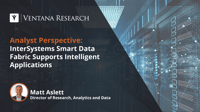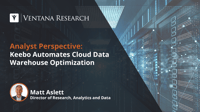The latest ISG Buyers Guide for Cloud Computing Platforms uncovers the market evolution of regional and global cloud providers. Buyers Guides for Public Cloud Platforms, Private Cloud Platforms and Hybrid Cloud Platforms are part of the recent software provider evaluations. ISG Software Research defines Cloud Platforms as a software service for organizations to access virtualized IT resources via the internet on a pay-per-use basis. These resources include servers, data processing power, data...
Read More
Topics:
Cloud Computing,
Digital Technology,
natural language processing,
Multi-Cloud,
ITOps,
Hybrid Cloud Platforms,
Accessibility,
Orchestration,
Sovereign Cloud
I am happy to share insights gleaned from our latest Buyers Guide, an assessment of how well software providers’ offerings meet buyers’ requirements. The Cloud Computing Platforms Ventana Research Buyers Guide is the distillation of a year of market and product research by ISG and Ventana Research.
Read More
Topics:
Cloud Computing,
Digital Technology
The technology landscape for enterprise IT faces a daunting challenge: complexity. As systems grow more intricate, organizations must actively seek ways to simplify the technology stack. This process, known as decomplexification, is crucial for enhancing efficiency, security and collaboration within an enterprise.
Read More
Topics:
Cloud Computing,
IT Service Management,
Digital Technology,
Digital Security,
DevOps and Platforms,
IoT and Edge Computing,
Intelligent Automation,
ITOps,
IaC,
CI/CD,
SASE
Enterprises are increasingly recognizing the need to streamline operations for efficiency, agility and innovation. This has led to various “operations” or “Ops” initiatives, each focusing on a specific aspect of enterprise IT. From software development and data analytics to IT and cloud management, these Ops groups are transforming the way enterprises operate and compete.
Read More
Topics:
Analytics,
Cloud Computing,
Digital Technology,
data operations,
digital finance,
Digital Security,
Observability,
Analytic Operations,
DevOps and Platforms,
ITOps,
CloudOps,
Machine Learning Operations,
MLOps,
SecOps,
ProjectOps,
AIOps,
NetOps,
DevSecOps,
SecFinOps
The migration of on-premises applications to the cloud has become more than just a technological shift; it’s a strategic imperative for enterprises. This transition, driven by the need for competitiveness, agility and responsiveness in a rapidly evolving business environment that operates at the speed of digital, is not a simple task. It requires a careful balance between the technology roadmap and the strategic business objectives of the organization.
Read More
Topics:
Cloud Computing,
Digital Technology,
CloudOps,
Migration
The increasing importance of intelligent operational applications driven by artificial intelligence (AI) is blurring the lines that have traditionally divided the requirements between operational and analytic data platforms. Operational data platforms have traditionally been deployed to support applications targeted at business users and decision-makers to run the business, with analytic data platforms typically supporting applications used by data and business analysts to analyze the business.
Read More
Topics:
embedded analytics,
Cloud Computing,
Analytics & Data,
operational data platforms,
Analytic Data Platforms,
AI and Machine Learning
Ventana Research recently announced its 2024 Market Agenda for Digital Technology. This agenda is designed to provide expertise to enterprises across various industries, helping them prioritize technology investments that enhance workforce effectiveness, customer engagement and enterprise agility. Digital Technology is especially important for CIO and Chief Digital Officers looking to rationalize and modernize their IT portfolio. Our expertise will see a significant expansion on this topic in...
Read More
Topics:
Business Continuity,
Cloud Computing,
IT Service Management,
Digital Technology,
Digital Security,
Observability,
DevOps and Platforms,
IoT and Edge Computing,
Intelligent Automation,
ITOps
In recent years, many enterprises have migrated data platform workloads from on-premises infrastructure to cloud environments, attracted by the promised benefits of greater agility and lower costs. The scale of cloud data platform adoption is illustrated by Ventana Research’s Data Lakes Dynamic Insights research: For two-thirds (66%) of participants, the primary data platform used for analytics is cloud based. As the quantity and importance of the data platform workloads deployed in the cloud...
Read More
Topics:
business intelligence,
Cloud Computing,
data operations,
robotic automation,
Analytics & Data,
Analytic Data Platforms,
AI and Machine Learning
Discussion about potential deployment locations for analytics and data workloads is often based on the assumption that, for enterprise workloads, there is a binary choice between on-premises data centers and public cloud. However, the low-latency performance or sovereignty characteristics of a significant and growing proportion of workloads make them better suited to data and analytics processing where data is generated rather than a centralized on-premises or public cloud environment. ...
Read More
Topics:
Cloud Computing,
Internet of Things,
Data,
Digital Technology,
Analytics & Data,
operational data platforms,
Analytic Data Platforms,
AI and Machine Learning
I recently discussed how fashion has a surprisingly significant role to play in the data market as various architectural approaches to data storage and processing take turns enjoying a phase in the limelight. Pendulum swing is a theory of fashion that describes the periodic movement of trends between two extremes, such as short and long hemlines or skinny and baggy/flared trousers. Pendulum swing theory is similarly a factor in data technology trends, with an example being the oscillation...
Read More
Topics:
Analytics,
Cloud Computing,
Data Management,
Data,
Digital Technology,
data operations,
Analytics & Data,
AI and Machine Learning


















